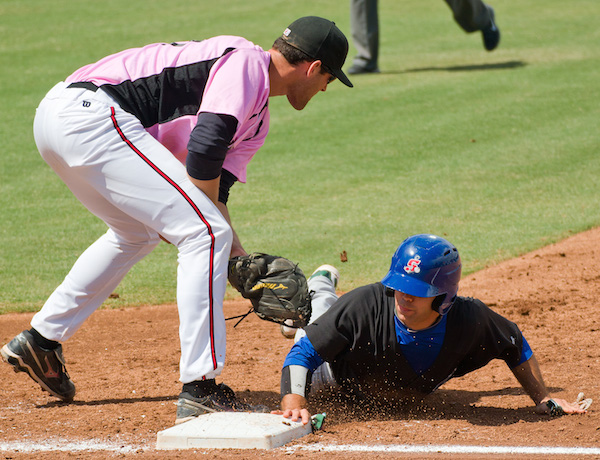Dear Sports Fan,
Why do baseball players slide? Surely it’s faster to keep running than to slide in the dirt, right?
Thanks,
Ellis
Dear Ellis,
Running is faster than sliding but speed isn’t the only consideration. Baseball players have two other reasons for sliding into a base: elusiveness and stickiness. In this post, we’ll explain each of the major reasons why baseball players slide instead of just running.
Often in a baseball game, a fielder only has to catch the ball while touching the base that a runner is headed toward in order to get him out. This is called a force play and we’ve covered it extensively before, in case you need a refresher. When a force play is not in effect, a fielder must tag the runner in order to get her out. Tagging involves having the ball securely, usually in her glove, and then touching the base runner with the hand or glove that’s holding the ball. In order for a tag to count, the fielder must touch the runner while he isn’t touching the base and must maintain control of the ball throughout the process. A tag is a rapid and precise moment. A fielder sets up near the base, reaches out to catch a throw from a teammate, and then sweeps the glove with the ball in the direction the runner is coming from to try to touch the runner before the runner is able to touch the base. It’s much easier for the fielder and for her teammate who is throwing the ball to aim waist to head high. This offers the best chance for a safely completed throw but it leaves the fielder with the ball pretty high up. Sliding on the ground forces the fielder to have to catch the ball and then sweep it down to reach the runner. This is slower and harder than tagging closer to the height at which the fielder caught the ball.
You might have wondered why I described a successful tag as needing to happen when the runner “isn’t touching the base” as opposed to “before the runner touches the base.” This is because a runner must maintain contact with the base in order to continue to be safe from tags. A runner that touches a base and then stops touching it while play is going on is at risk for being tagged. Sliding helps a base runner stay in touch with the base they are aiming at for the very reason you suggested sliding might not be a good idea – sliding slows the runner down. Sliding is perhaps the only way for a very fast runner to shed the speed she needs to in order to not run by or overrun the base.
There is one giant exception to these calculations about sliding and that’s first base. Because there is always a force play at first base, the first baseman never needs to worry about tagging the runner. Perhaps as a way to even things out, baseball rules allow the runner a similar advantage — the runner doesn’t need to stay in contact with first base. Once a runner touches first base, they are considered on the base as long as they don’t make a move toward second base. This evens things out – the fielder doesn’t have to tag the runner and the runner doesn’t need to bother sliding. Once in a while, you’ll still see players, even professional players, slide in to first base anyway! This is a dumb move and is always met with skepticism and scorn by announcers and knowledgeable fans. Feel free to join in!
Thanks for reading,
Ezra Fischer

